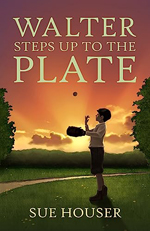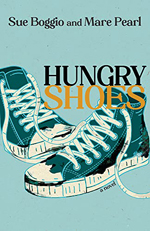Rosalie Rayburn is a journalist and author who has lived and worked around the world including the U.S., Europe, Australia, and Saudi Arabia. Her 18 years spent as a staff writer for the Albuquerque Journal inspired her Digger Doyle Mysteries that follow a young reporter with an eye for exposing corrupt politicians. Windswept (November 2024) is Rosalie’s latest release and the third novel in the mystery series. Look for Rosalie on her website RosalieRayburn.com and blog, and on Facebook and her Amazon author page. Windswept is available here.
 Your new book, Windswept, is noted as being a continuation of your first two books. Are you happy with how the plot and characters have developed?
Your new book, Windswept, is noted as being a continuation of your first two books. Are you happy with how the plot and characters have developed?
Yes. I started writing the first book, The Power of Rain, more or less for fun when my son was a New Mexico Military Institute student. I would write the story in my head as I made the long drive down to visit him in Roswell. There’s a lot of empty road on that journey. I then joined a writing group, and members of the group encouraged me to continue. They liked my characters, Digger, the reporter, and her artist/activist girlfriend, Maria Ortiz. They wanted to know what happened to them after the end of the first book. I did, too. Over the course of the three books, I have grown to enjoy my characters more and more. I love wise old grandmother Abuela, who advises Digger and Maria. I love the villainous property developer Danny Murphy, and I enjoy the crisis of conscience suffered by the politicians who are hoodwinked by unscrupulous people.
When looking for inspiration for your works, what are the two or three things that mostly motivate you to write?
I have drawn on my experience as a reporter for the Albuquerque Journal. I spent about eight years covering local city and county politics. You get to see all the prejudices, the NIMBYism, the bizarre decisions public figures sometimes make. Many people think public meetings are boring, but to me, they became a form of theater. It was fascinating to see how the characters interacted and to observe their conflicting loyalties. Another thing: when I was a reporter, I spent a few years covering energy policy. I learned a lot about renewable energy, solar, and wind. I am passionate about efforts to combat climate change. This is especially important in New Mexico because of drought and wildfires.
As an author, do you plan out the whole written work (and accompanying plot and story line) in advance, or is yours a more spontaneous and flowing style?
I only had a faint idea of where I wanted the story to go in my first book. In my second book, The Sunshine Solution, I sketched a plot. But early on, I decided I wanted to make it more of a mystery, so I veered off the outline. I followed a similar process with Windswept. I have the overall idea, but sometimes I get to a point where I have to figure out a character’s motivation or a way to get them from one point to the next without revealing the plot too early in the book.
 What have been some of the challenges facing you as a writer in this third novel?
What have been some of the challenges facing you as a writer in this third novel?
Windswept is my first murder mystery. The mystery in the first two books revolved around politics and a business scam. I didn’t have much experience covering the police beat as a reporter, so I had to do more research for Windswept. Also, I have been spending more time away from New Mexico, so writing the details about the landscape and weather was harder. Readers have said the New Mexico landscape is almost like a character in my books, so this was a significant challenge when I wrote Windswept. Thank goodness for internet research and Google Earth.
How did you come up with the title for Windswept? Was it hard checking to see if the title had already been used in another publication?
An early scene in Windswept occurs at a wind farm in eastern New Mexico. That is the setting for the discovery of the first murder. Windswept seemed like an apt title that fit with the environmental theme in the titles of my first two books. Checking on Amazon makes it easy to find out if there other books with the same title. I have found a couple of other books that include “Windswept” as part of the title. For my second book, I had originally planned to call it “Sunshine Dreams,” but the editor I used informed me that there were songs or bands that had that title. I subsequently changed it to The Sunshine Solution.
Before attending Trinity College in Dublin, Ireland, where did you go to school?
My family left the U.S. and moved to Europe when I was nine years old because my father got a job working for the U.S. Air Force. From third grade onward, I went to a girl’s boarding school in England. He then retired to Ireland, where my maternal grandparents had emigrated from. That’s why I went to Trinity College Dublin.
Who are some of your greatest mentors in writing?
Honestly, I would have to say my high school English teacher Rosemary Scott. I am still in touch with her. I also owe a lot to the members of my writing group in Albuquerque. They gave great feedback and encouragement. My editors at the Albuquerque Journal, being a reporter honed my skills in noticing details and conducting research.
Would you describe your work style as crime/thriller (more of a hard edge) or mystery/adventure (perhaps, a younger style)?
I’m probably more into mystery/adventure. I am not into grisly stuff.
In thinking about your published works, are there any close parallels to other authors?
Maybe the Rita Mars mysteries by Valerie Webster, the books have a lesbian former investigative reporter as the main character.
 Your blog life posts describe in great detail your life in Portugal with your pet. How do you think living in Portugal has inspired, or changed, your writing?
Your blog life posts describe in great detail your life in Portugal with your pet. How do you think living in Portugal has inspired, or changed, your writing?
Living in Portugal has made me nostalgic for New Mexico. I think that’s why I write about the landscape, the unique culture, and the food. I miss those things.
What advice would you give to young writers who are just starting out today?
Keep writing. Write what makes your heart sing. Don’t expect to get rich and famous!
Do you ever think about returning to Saudi Arabia? Or Norway? Are they buying your books there?
I revisited Norway a few years ago and plan to return there again in 2025. A friend of mine in Stavanger is a member of a book club that chose The Power of Rain as one of their books. No plans to revisit Saudi Arabia.
How often do you write? Are you excited about promoting your latest book?
When I’m working on a book, I try to spend some time each day either writing or planning the next move, conversation, or chapter. I am looking forward to doing several book reading/signing events in Albuquerque in January.
Is there anything else you’d like readers to know?
I am planning to write a fourth Digger Doyle mystery, and I would like to turn my books into audiobooks.
 Christina Sultan is a former Albuquerque and Santa Fe, New Mexico resident who joined SouthWest Writers in 2022. A graduate of the English literature program at McGill University, Montreal, she has been an avid reader and writer of literary criticism all her life. She interned as a journalist at United Press International before working at the Whistler Question Newspaper and Whistler Magazine. She then went on to obtain a master’s degree in business in California. She was named to Who’s Who U.S.A. in 2007 and devotes much of her time to working in the arts, investments, and the humanities.
Christina Sultan is a former Albuquerque and Santa Fe, New Mexico resident who joined SouthWest Writers in 2022. A graduate of the English literature program at McGill University, Montreal, she has been an avid reader and writer of literary criticism all her life. She interned as a journalist at United Press International before working at the Whistler Question Newspaper and Whistler Magazine. She then went on to obtain a master’s degree in business in California. She was named to Who’s Who U.S.A. in 2007 and devotes much of her time to working in the arts, investments, and the humanities.


 KL Wagoner loves creating worlds of fantasy and science fiction. Her current work in progress is The Last Bonekeeper fantasy trilogy and short stories in the same universe. A member of SouthWest Writers since 2006, Kat has worked as the organization’s secretary, newsletter editor, website manager, and author interview coordinator. Kat is also a veteran, a martial art student, and a grandmother. Visit her at
KL Wagoner loves creating worlds of fantasy and science fiction. Her current work in progress is The Last Bonekeeper fantasy trilogy and short stories in the same universe. A member of SouthWest Writers since 2006, Kat has worked as the organization’s secretary, newsletter editor, website manager, and author interview coordinator. Kat is also a veteran, a martial art student, and a grandmother. Visit her at 
 Su Lierz writes dark fiction, short story fiction, and personal essays. Her short story “Twelve Days in April,” written under the pen name Laney Payne, appeared in the 2018 SouthWest Writers Sage Anthology. Su was a finalist in the 2017 and 2018 Albuquerque Museum Authors Festival Writing Contest. She lives in Corrales, New Mexico, with her husband Dennis.
Su Lierz writes dark fiction, short story fiction, and personal essays. Her short story “Twelve Days in April,” written under the pen name Laney Payne, appeared in the 2018 SouthWest Writers Sage Anthology. Su was a finalist in the 2017 and 2018 Albuquerque Museum Authors Festival Writing Contest. She lives in Corrales, New Mexico, with her husband Dennis.




































